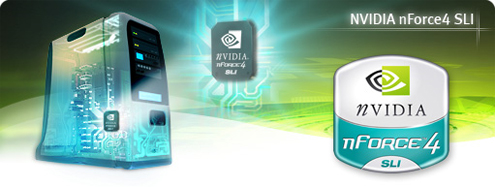nForce4 SLI Motherboards: Premium Performance at a Bargain Price
by Gary Key on January 3, 2006 12:05 AM EST- Posted in
- Motherboards
We reviewed a few nForce4 SLI motherboards several months ago and found that while SLI was very promising, it was a technology that still needed to mature. We also found the motherboards to be immature and required a great deal of tweaking in order to extract the best possible performance and stability from the platform. In addition, the cost of the motherboards was at the premium end of the pricing scale along with limited availability from the board suppliers.
Since that time, NVIDIA's SLI technology has not only matured a great deal, but recently evolved with the release of the nForce4 SLI X16 platform. The availability of SLI motherboards is now widespread from most manufacturers and you will find more nForce4 SLI offerings than nForce4 Ultra products. Along with this is the widespread availability of SLI capable video cards that cover everything from the 6600LE to the Quadro FX4500 GPU chipsets making SLI a mainstream choice now.
Today, we are reviewing the Asus A8N-SLI Premium, Foxconn NF4SK8AA-8KRS, and Albatron K8SLI based on the NVIDIA nForce4 SLI chipset. Asus's offering is an update to the A8N-SLI Deluxe and fits into their product line between the value segment A8N-SLI and flagship A8N32-SLI. Albatron's offering is their only nForce4 SLI product and is designed for the value segment. Foxconn's contribution is their value segment nForce4 SLI product with their upscale NF4SK8AA-8EKRS, offering an additional Gigabit Ethernet port, SI-3132 SATA II Raid, and IEEE-1394a support.
Let's see what these boards are capable of and if a premium price ensures premium performance.
Since that time, NVIDIA's SLI technology has not only matured a great deal, but recently evolved with the release of the nForce4 SLI X16 platform. The availability of SLI motherboards is now widespread from most manufacturers and you will find more nForce4 SLI offerings than nForce4 Ultra products. Along with this is the widespread availability of SLI capable video cards that cover everything from the 6600LE to the Quadro FX4500 GPU chipsets making SLI a mainstream choice now.

Today, we are reviewing the Asus A8N-SLI Premium, Foxconn NF4SK8AA-8KRS, and Albatron K8SLI based on the NVIDIA nForce4 SLI chipset. Asus's offering is an update to the A8N-SLI Deluxe and fits into their product line between the value segment A8N-SLI and flagship A8N32-SLI. Albatron's offering is their only nForce4 SLI product and is designed for the value segment. Foxconn's contribution is their value segment nForce4 SLI product with their upscale NF4SK8AA-8EKRS, offering an additional Gigabit Ethernet port, SI-3132 SATA II Raid, and IEEE-1394a support.
Let's see what these boards are capable of and if a premium price ensures premium performance.










37 Comments
View All Comments
Gary Key - Wednesday, January 4, 2006 - link
As stated in the article the current pricing structure lends itself to the purchase of an SLI capable motherboard if the nForce4 is your chipset of choice. Even if you do not utilize SLI you at least have the option of doing so, if not for gaming, then for multiple monitor support and excellent performance utilizing two x8 lanes. If you look at the current support from the motherboard suppliers and product plans it is very obvious that SLI/CrossFire capable motherboards are becoming the standard across all price points. Our statements were based on these facts regarding the motherboard choices available. If you consider the potential cost/performance benefits then why pay the same amount of money for a board that is not capable of SLI or CrossFire and will probably not receive the same level of support over the lifespan of the product.
bob661 - Wednesday, January 4, 2006 - link
Isn't this a contradiction?
Capt Caveman - Tuesday, January 3, 2006 - link
What are you talking about? You can get a SLI board for $70.andlcool - Tuesday, January 3, 2006 - link
for the asus one, it should be ddr and not ddr2.ElFenix - Tuesday, January 3, 2006 - link
still, should be a good price for stock speed boardsElFenix - Tuesday, January 3, 2006 - link
looking at the first chart i mean. doesn't seem to fall off much eh?<--- wants an edit function
Gary Key - Tuesday, January 3, 2006 - link
The Foxconn board offered excellent stability throughout testing although it certainly is not targeted at the overclocking crowd. The performance was certainly acceptable and without the benchmarks you probably would not be able to tell the difference between it and the other boards. The layout is really nice unless you plan on utilizing two video cards with two slot cooling solutions as the space becomes very tight between the two x16 slots.I would like an edit function also. ;->